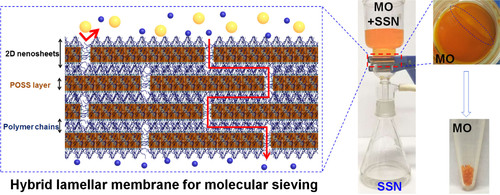Our official English website, www.x-mol.net, welcomes your feedback! (Note: you will need to create a separate account there.)
Toward the Highly Ordered Lamellar Hybrid Membrane for Molecular Sieving by One-Pot Self-Assembly of Hybrid Hyperbranched Polymer
CCS Chemistry ( IF 11.2 ) Pub Date : 2020/5/25 , DOI: 10.31635/ccschem.020.201900105 Jin Li 1 , Zhilong Su 1 , Xiaodong Ma 1 , Jie Yin 1 , Xuesong Jiang 1
CCS Chemistry ( IF 11.2 ) Pub Date : 2020/5/25 , DOI: 10.31635/ccschem.020.201900105 Jin Li 1 , Zhilong Su 1 , Xiaodong Ma 1 , Jie Yin 1 , Xuesong Jiang 1
Affiliation

|
Ordered lamellar hybrid membranes are of great interest, due to their application as functional materials, including molecular sieving, biosensors, optical devices, and drug, as well as gene deliveries, but their fabrication remains challenging because three critical issues regarding synthesis of regular nanosheets, interfacing, and their spatial distribution in a polymer matrix are difficult to address simultaneously. Here, we fabricated a well-defined hybrid lamellar membrane through one-pot self-assembly, whose structure consisted of alternating layers of hydrophilic hyperbranched poly(ether amine) (hPEA) and polyhedral oligomeric silsesquioxane (POSS). The POSS-capped photosensitive hPEA initially formed ultrathin sandwich-like hybrid nanosheets (HNS) with a thickness of 5?±?0.5 nm in an aqueous solution through a living crystallization-driven self-assembly, which subsequently, generated a highly ordered lamellar hybrid membrane with a uniform layer of spacing through direct self-stacking by filtration. The resulting membrane acquired a well-defined lamellar structure, thereby providing an ideal model to study molecular diffusion in confined spaces. Also, it could be used for the separation of molecules of different sizes or charges in water solution and is capable of being efficiently, effectively, and economically (known as 3E) applied for the purification of products of methyl orange and fluorescein from their precursor mixtures. This one-pot assembly of the hybrid polymer provides a facile and essential alternative to fabricate highly ordered hybrid membranes.
中文翻译:

通过杂化超支化聚合物一锅自组装向分子筛筛选高阶层状杂化膜迈进
有序的层状杂化膜作为分子筛,生物传感器,光学设备,药物以及基因传递等功能材料的应用而备受关注,但由于常规纳米片的合成存在三个关键问题,因此其制造仍然具有挑战性,界面,以及它们在聚合物基质中的空间分布很难同时解决。在这里,我们通过一锅自组装制造了清晰的混合层状膜,其结构由亲水性超支化聚醚醚(hPEA)和多面体低聚倍半硅氧烷(POSS)的交替层组成。用POSS封盖的光敏hPEA最初形成的超薄三明治状杂化纳米片(HNS)的厚度为5?±?0。通过活性结晶驱动的自组装在水溶液中溶解5 nm,随后通过过滤直接自堆叠产生高度有序的层状杂化膜,具有均匀的间隔层。所得的膜具有良好定义的层状结构,从而为研究分子在受限空间中的扩散提供了理想的模型。此外,它还可用于分离水溶液中不同大小或电荷的分子,并且能够高效,有效且经济地(称为3E)应用于从其前体混合物中纯化甲基橙和荧光素的产物。杂化聚合物的这种一锅法组装为制造高度有序的杂化膜提供了一种简便而必要的替代方法。通过过滤直接自堆叠产生了高度均匀的层状杂化膜。所得的膜具有良好定义的层状结构,从而为研究分子在受限空间中的扩散提供了理想的模型。此外,它还可用于分离水溶液中大小或电荷不同的分子,并且能够高效,有效且经济地(称为3E)用于从前体混合物中纯化甲基橙和荧光素的产物。杂化聚合物的这种一锅法组装为制造高度有序的杂化膜提供了一种简便而必要的替代方法。通过过滤直接自堆叠产生高度均匀的层状杂化膜。所得的膜具有良好定义的层状结构,从而为研究分子在受限空间中的扩散提供了理想的模型。此外,它还可用于分离水溶液中大小或电荷不同的分子,并且能够高效,有效且经济地(称为3E)用于从前体混合物中纯化甲基橙和荧光素的产物。杂化聚合物的这种一锅法组装为制造高度有序的杂化膜提供了一种简便而必要的替代方法。所得的膜具有良好定义的层状结构,从而为研究分子在受限空间中的扩散提供了理想的模型。此外,它还可用于分离水溶液中大小或电荷不同的分子,并且能够高效,有效且经济地(称为3E)用于从前体混合物中纯化甲基橙和荧光素的产物。杂化聚合物的这种一锅法组装为制造高度有序的杂化膜提供了一种简便而必要的替代方法。所得的膜具有良好定义的层状结构,从而为研究分子在受限空间中的扩散提供了理想的模型。此外,它还可用于分离水溶液中大小或电荷不同的分子,并且能够高效,有效且经济地(称为3E)用于从前体混合物中纯化甲基橙和荧光素的产物。杂化聚合物的这种一锅法组装为制造高度有序的杂化膜提供了一种简便而必要的替代方法。从经济上讲(称为3E)可用于从其前体混合物中纯化甲基橙和荧光素的产物。杂化聚合物的这种一锅法组装为制造高度有序的杂化膜提供了一种简便而必要的替代方法。从经济上讲(称为3E)可用于从其前体混合物中纯化甲基橙和荧光素的产物。杂化聚合物的这种一锅法组装为制造高度有序的杂化膜提供了一种简便而必要的替代方法。
更新日期:2020-09-16
中文翻译:

通过杂化超支化聚合物一锅自组装向分子筛筛选高阶层状杂化膜迈进
有序的层状杂化膜作为分子筛,生物传感器,光学设备,药物以及基因传递等功能材料的应用而备受关注,但由于常规纳米片的合成存在三个关键问题,因此其制造仍然具有挑战性,界面,以及它们在聚合物基质中的空间分布很难同时解决。在这里,我们通过一锅自组装制造了清晰的混合层状膜,其结构由亲水性超支化聚醚醚(hPEA)和多面体低聚倍半硅氧烷(POSS)的交替层组成。用POSS封盖的光敏hPEA最初形成的超薄三明治状杂化纳米片(HNS)的厚度为5?±?0。通过活性结晶驱动的自组装在水溶液中溶解5 nm,随后通过过滤直接自堆叠产生高度有序的层状杂化膜,具有均匀的间隔层。所得的膜具有良好定义的层状结构,从而为研究分子在受限空间中的扩散提供了理想的模型。此外,它还可用于分离水溶液中不同大小或电荷的分子,并且能够高效,有效且经济地(称为3E)应用于从其前体混合物中纯化甲基橙和荧光素的产物。杂化聚合物的这种一锅法组装为制造高度有序的杂化膜提供了一种简便而必要的替代方法。通过过滤直接自堆叠产生了高度均匀的层状杂化膜。所得的膜具有良好定义的层状结构,从而为研究分子在受限空间中的扩散提供了理想的模型。此外,它还可用于分离水溶液中大小或电荷不同的分子,并且能够高效,有效且经济地(称为3E)用于从前体混合物中纯化甲基橙和荧光素的产物。杂化聚合物的这种一锅法组装为制造高度有序的杂化膜提供了一种简便而必要的替代方法。通过过滤直接自堆叠产生高度均匀的层状杂化膜。所得的膜具有良好定义的层状结构,从而为研究分子在受限空间中的扩散提供了理想的模型。此外,它还可用于分离水溶液中大小或电荷不同的分子,并且能够高效,有效且经济地(称为3E)用于从前体混合物中纯化甲基橙和荧光素的产物。杂化聚合物的这种一锅法组装为制造高度有序的杂化膜提供了一种简便而必要的替代方法。所得的膜具有良好定义的层状结构,从而为研究分子在受限空间中的扩散提供了理想的模型。此外,它还可用于分离水溶液中大小或电荷不同的分子,并且能够高效,有效且经济地(称为3E)用于从前体混合物中纯化甲基橙和荧光素的产物。杂化聚合物的这种一锅法组装为制造高度有序的杂化膜提供了一种简便而必要的替代方法。所得的膜具有良好定义的层状结构,从而为研究分子在受限空间中的扩散提供了理想的模型。此外,它还可用于分离水溶液中大小或电荷不同的分子,并且能够高效,有效且经济地(称为3E)用于从前体混合物中纯化甲基橙和荧光素的产物。杂化聚合物的这种一锅法组装为制造高度有序的杂化膜提供了一种简便而必要的替代方法。从经济上讲(称为3E)可用于从其前体混合物中纯化甲基橙和荧光素的产物。杂化聚合物的这种一锅法组装为制造高度有序的杂化膜提供了一种简便而必要的替代方法。从经济上讲(称为3E)可用于从其前体混合物中纯化甲基橙和荧光素的产物。杂化聚合物的这种一锅法组装为制造高度有序的杂化膜提供了一种简便而必要的替代方法。


























 京公网安备 11010802027423号
京公网安备 11010802027423号